
Looking for How to store fruits and vegetables at home in 2025? Scroll down this page and follow the links. And if you bring home some fruit or vegetables and want to can, freeze, make jam, salsa or pickles, see this page for simple, reliable, illustrated canning, freezing or preserving directions. There are plenty of other related resources, click on the resources dropdown above. If you are having a hard time finding canning lids, I've used these, and they're a great price & ship in 2 days.
If you have questions or feedback, please let me know! There are affiliate links on this page. Read our disclosure policy to learn more.
How to store fruits and vegetables at home
How to store fruits and vegetables at home
Long storage life also depends on careful handling. Most fruits and vegetables are easily bruised if not handled carefully. When harvesting, treat produce gently. Most produce should be washed after harvest and before storage, but there are some exceptions. Delicate berries should be rinsed in cold water just before consuming. Washing berries before storage will hasten the decay process. While potatoes store better with a fine layer of soil left on the skin, avoid leaving clumps of soil on potatoes as this will only encourage spoilage.
Several vegetables benefit from post-harvest curing. Curing heals or suberizes injures from harvesting operations. It thickens the skin, reducing moisture loss and affording better protection against insect and microbial invasion. Curing is usually accomplished at an elevated storage temperature and high humidity. An enclosed home storage area with a space heater can provide the conditions effective for curing some crops.
Root crops such as beets, carrots, rutabagas, parsnips and turnips can be left in the ground into late fall and early winter. A heavy mulch of straw will prevent the ground from freezing so the roots can be dug when needed. Many people prefer the taste of these crops after they have been frosted because their flavors become sweeter and milder. But make sure to finish harvesting these crops before the ground freezes solid, or you will have to wait until spring to dig them out.
Recommendations for Handling Some Specific Fruits and Vegetables:
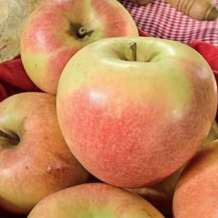 Apples:
Late maturing apples are best suited for storage. Store in baskets or boxes lined with plastic or foil to
help retain moisture. Always sort apples carefully and avoid bruising them. Store apples as close to 32°F as
possible, a temperature of 30 to 32°F is ideal. Because apples give off a gas, ethylene, that will hasten
the ripening of other fruit, store apples separately from other crops if possible. Boxed apples need to be
kept in a cool, dark spot where they won't freeze. Freezing ruptures all of an apple's cells, turning it
into one large bruise overnight. The usual solution is to store apples in a root cellar. But root cellars
often have potatoes in them, and experts say that apples and potatoes should never be stored in the same
room. This may seem incongruous, but there is a reason. As they age, potatoes release an otherwise harmless
gas that makes apples spoil faster. If you can keep the gas away from your apples, they will keep just fine.
Just don't store them right next to potatoes. Apples:
Late maturing apples are best suited for storage. Store in baskets or boxes lined with plastic or foil to
help retain moisture. Always sort apples carefully and avoid bruising them. Store apples as close to 32°F as
possible, a temperature of 30 to 32°F is ideal. Because apples give off a gas, ethylene, that will hasten
the ripening of other fruit, store apples separately from other crops if possible. Boxed apples need to be
kept in a cool, dark spot where they won't freeze. Freezing ruptures all of an apple's cells, turning it
into one large bruise overnight. The usual solution is to store apples in a root cellar. But root cellars
often have potatoes in them, and experts say that apples and potatoes should never be stored in the same
room. This may seem incongruous, but there is a reason. As they age, potatoes release an otherwise harmless
gas that makes apples spoil faster. If you can keep the gas away from your apples, they will keep just fine.
Just don't store them right next to potatoes.Prevent contact between apples stored for the winter by wrapping them individually in sheets of newspaper. The easiest way to do this is to unfold a section of newspaper all the way and tear it into quarters. Then stack the quarters. Avoid sections printed with colored ink, which contains poisonous heavy metals |
 Garlic:
Harvest garlic in mid-summer when the plant still retains 5 green leaves. Cure garlic in a warm, dry place
with good air circulation for 1 month before cutting the tops and roots back. Hardneck garlic will store
between 3-9 months while softneck garlic will store for 6-12 months or more. Garlic:
Harvest garlic in mid-summer when the plant still retains 5 green leaves. Cure garlic in a warm, dry place
with good air circulation for 1 month before cutting the tops and roots back. Hardneck garlic will store
between 3-9 months while softneck garlic will store for 6-12 months or more. |
|
|
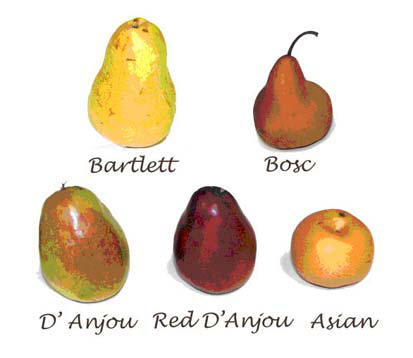 Pears:
For good flavor and texture, ripen pears after harvest. Pick pears when they are fully mature, firm in
texture and light green in color. Ripen pears by placing them in a room at 60 to 65°F for 1 to 3 weeks. Once
pears ripe, the fruit is soft and a yellow-green color, transfer to the refrigerator and store at 29 to 32°F
and 90% humidity. Pears:
For good flavor and texture, ripen pears after harvest. Pick pears when they are fully mature, firm in
texture and light green in color. Ripen pears by placing them in a room at 60 to 65°F for 1 to 3 weeks. Once
pears ripe, the fruit is soft and a yellow-green color, transfer to the refrigerator and store at 29 to 32°F
and 90% humidity. |
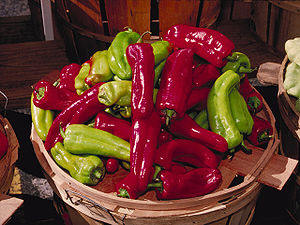 Peppers
Sweet and hot peppers: Peppers
Sweet and hot peppers: Bell peppers. Store these in a cool place, however, cold temperatures in the refrigerator can cause them to break down faster. If you don't have a cool spot for storage, in the refrigerator peppers will last for a few days. Mature, green bell peppers can be kept for 2 to 3 weeks if handled properly. Firm, dark green peppers free of blemishes and injury are best for storage. Harvest before frost to avoid damage to the fruit. Hot peppers are easiest to store after they are dry. Peppers can be dried by either pulling the plants together and hanging them upside down or by picking the peppers from the plants and stringing them together. Hot peppers. Like bell peppers, hot peppers do better outside of the refrigerator. Store jalapenos, poblanos and serrano chiles at room temperature. If you will use them within a few days, you can keep them in the refrigerator |
 Potatoes:
Late crop potatoes are best for long-term storage. After harvest, cure late potatoes by holding them in
moist air for 1 to 2 weeks at 60 to 75°F. Lightly cover during curing to help retain moisture. After curing,
lower the storage temperature to about 40 to 45°F, ideally in a cool, dark basement or cellar. Store in a
cool but not cold place and keep them away from ethylene producing fruit and strong-smelling garlic, onions
and leeks, which can impart their flavors onto potatoes.Do not wash potatoes before they are put into
storage and avoid chilling below 40°F. Store potatoes in the dark to prevent greening. Potatoes:
Late crop potatoes are best for long-term storage. After harvest, cure late potatoes by holding them in
moist air for 1 to 2 weeks at 60 to 75°F. Lightly cover during curing to help retain moisture. After curing,
lower the storage temperature to about 40 to 45°F, ideally in a cool, dark basement or cellar. Store in a
cool but not cold place and keep them away from ethylene producing fruit and strong-smelling garlic, onions
and leeks, which can impart their flavors onto potatoes.Do not wash potatoes before they are put into
storage and avoid chilling below 40°F. Store potatoes in the dark to prevent greening. |
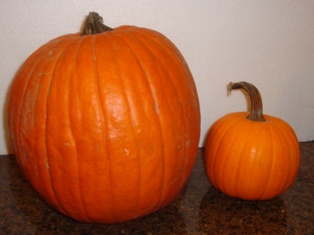 Pumpkins
and winter squash: Harvest mature fruit with hard rinds (ones that resist fingernail pressure) just
before frost. Leave the stem on when cutting from the plants to prevent decay. Cure for 10 days at 80 to
85°F. The one exception is acorn squash: store at 45°F after harvest. (Curing acorn squash will lead to
stringiness.) They don't do well in the refrigerator. In a cool garage (but above freezing always) or
basement, they can store for months. Pumpkins
and winter squash: Harvest mature fruit with hard rinds (ones that resist fingernail pressure) just
before frost. Leave the stem on when cutting from the plants to prevent decay. Cure for 10 days at 80 to
85°F. The one exception is acorn squash: store at 45°F after harvest. (Curing acorn squash will lead to
stringiness.) They don't do well in the refrigerator. In a cool garage (but above freezing always) or
basement, they can store for months. |
| Root crops - general - Store beets, carrots, parsnips, rutabaga and turnips at cold
temperatures (33 - 40), but always above freezing, in the refrigerator. If you have a root cellar, store them there for the long haul. In very cold environments, people life the root crops, and then bury them in boxes of sand, leaving the tops above the soil line. In climates where the soil does not freeze, people construct boxes above ground, and fill them with lavers of the root crops and sand or leaves, straw, etc). Of course there must be protection against animals. Typically, the bottom of the box is lines with hardware mesh (1/2 openings) and the box lid securely closes. |
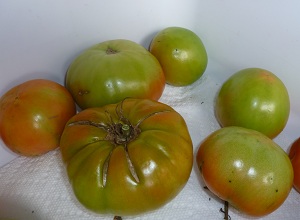 Tomatoes:
With care, mature green tomatoes will keep and ripen for about 4 to 6 weeks in the fall. Harvest tomatoes
from vigorous vines, tomatoes from nearly spent vines are more subject to decay. Harvest fruit just before
the first killing frost. To store, pick tomatoes and remove the stems. Reduce rot by disinfecting fruit by
washing in water with 1-1/2 teaspoon bleach per gallon of water. Dry thoroughly with a soft cloth and pack
fruit 1 or 2 layers deep in shallow boxes. Remove fruits as they ripen. Tomatoes:
With care, mature green tomatoes will keep and ripen for about 4 to 6 weeks in the fall. Harvest tomatoes
from vigorous vines, tomatoes from nearly spent vines are more subject to decay. Harvest fruit just before
the first killing frost. To store, pick tomatoes and remove the stems. Reduce rot by disinfecting fruit by
washing in water with 1-1/2 teaspoon bleach per gallon of water. Dry thoroughly with a soft cloth and pack
fruit 1 or 2 layers deep in shallow boxes. Remove fruits as they ripen. Do not refrigerate! Cold temperatures result in mealy tomatoes devoid of flavor. |
Basil. Storage in the refrigerator can brown the leaves and speed up basil's demise. Store it at room temperature with stems places in a jar of water. Large bunches can double as a centerpiece
Beets. Greens draw moisture out of root vegetables. Remove them and store separately in the refrigerator for up to a few days. Store the beets in the crisper drawer for up to 10 days.
Bok choy. Store in the refrigerator for up to a week in a cloth produce bag.
Broccoli. Broccoli perishes quickly. Store it in the refrigerator in a cloth produce bag and eat within three or four days.
Brussels sprout. Like broccoli, brussels sprout perish quickly. Store them in the refrigerator in a cloth produce bag and eat within a few days. I can sometimes buy them on the stalk but can't quite fit that in my refrigerator so I try to use them up almost immediately when I buy them this way.
Cabbage. Store loose in the crisper drawer and use within about two weeks.
Carrots. Remove the greens for a carrot green pesto later and store in the refrigerator in a cloth produce bag or loose in the crisper drawer. They will keep for a week or longer.
Cauliflower. Store this loose in the refrigerator crisper drawer. Use it within a week.
Celery. Store your celery in the refrigerator. I don't bother putting it in a cloth produce bag but you can if you prefer. I put a few sad looking stalks in a jar of water and left that jar out on my kitchen counter. It perked up after half a day or so and actually looked better than fresh new celery I had socked away in the refrigerator. If you store your celery this way, change the water mid-week.
Corn. Within hours of being picked, corn loses up to 40 percent of its sugar. Eat it as soon as you get it. If you must store it, put it in a warmer part of the refrigerator in the husk for up to three days.
Cucumber. The refrigerator is too cool for these and can damage the texture. They do best around 50 degrees Fahrenheit—much warmer than the refrigerator. If you do store them in the refrigerator, eat them within a few days.
Dark leafy greens. I like to prep greens—chard, collards, kale and spinach—in advance as they turn very quickly. Remove the stems, cut, wash and spin dry in a cloth produce bag (I do this outside). Store them in the same now-damp but not wet cloth produce bag. Use them up within a week.
Eggplant. Store at room temperature. Colder temperatures can damage them. They will keep for about a week maybe more.
Green beans. These perish quickly so gobble them up soon after buying. Store them in a cloth produce bag in the refrigerator for about three days. Cut off the stem only, not the edible end. This reduces waste and saves time.
Herbs. Store in cloth produce bags in the refrigerator for up to a week (except for basil—see basil above).
Lettuce. Store lettuce in the refrigerator. (Romaine, butter lettuce, green leaf lettuce, red leaf lettuce), not salad mix and prep it the same way as dark leafy greens. Cut, wash, spin, then store in cloth produce bag in the refrigerator for up to a week.
Leeks. Store them in the refrigerator for up to two weeks.
Onions and shallots. Store them in a cool, dry place but not in the refrigerator, as the cold temperature can damage the flavor and texture.
Peaches Highly perishable peaches will turn quickly so gobble them up while they're fresh. If you some that are hard, store them at room temperature until ripe, then transfer to the refrigerator for up to several days.
Radishes. Remove the greens and store separately for a few days in the refrigerator. Store the radishes themselves in a cloth produce bag, also in the refrigerator, for up to two weeks.
Scallions (aka green onions). Store them in a cloth produce bag in the refrigerator and use within a week.
Sprouts. If you make these yourself, wait until they have completely dried from their final rinse before you store them in either a cloth produce bag, glass jar or glass container. Store purchased sprouts in the same manner.
Summer squash (such as zucchini). This perishes quickly. Store in the refrigerator for up to several days.
Sweet potatoes. Like regular potatoes, store in a cool place but do not refrigerate.
Watermelon. Keep these at room temperature. Cold temperatures can damage their flesh, resulting in pitting and loss of color and flavor. Watermelons are ethylene-sensitive, so keep them away from fruit that produce high amounts of ethylene.
Many fall-harvested crops lend themselves to long term storage. The following storage conditions are recommended for extended shelf life and maximum eating quality of fall produce:
Many fall-harvested crops lend themselves to long term storage. The following storage conditions are recommended for extended shelf life and maximum eating quality of fall produce:
| Storage Temperature, Humidity & Storage Life of Selected Fruits and Vegetables1 | |||
| Commodity | Temperature (°F) | Relative Humidity (%) | Storage Life |
| Apples, late season | 30-38 | 95 | 2-6 months |
| Beet, bunched | 32 | 98-100 | 10-14 days |
| Beet, topped | 32 | 98-100 | 4-6 months |
| Broccoli | 32 | 95-100 | 10-14 days |
| Brussels Sprouts | 32 | 95-100 | 3-5 weeks |
| Cabbage | 32 | 98-100 | 3-6 weeks |
| Carrot, bunched | 32 | 95-100 | 2 weeks |
| Carrot, mature | 32 | 98-100 | 7-9 months |
| Cauliflower | 32 | 95-98 | 3-4 weeks |
| Celeriac | 32 | 97-99 | 6-8 months |
| Celery | 32 | 98-100 | 2-3 months |
| Garlic | 32 | 65-70 | 6-7 months |
| Horseradish | 30-32 | 98-100 | 10-12 months |
| Kale | 32 | 95-100 | 2-3 weeks |
| Kohlrabi | 32 | 98-100 | 2-3 months |
| Onion, dry | 32 | 65-70 | 1-8 months |
| Parsnip | 32 | 98-100 | 4-6 months |
| Pears | 34-36 | 95 | 2-4 months |
| Pepper, sweet | 45-55 | 90-95 | 2-3 weeks |
| Potato, late | 50-60 | 90-95 | 5-10 months |
| Radish, winter | 32 | 95-100 | 2-4 months |
| Rutabaga | 32 | 98-100 | 4-6 months |
| Squash, winter | 50 | 50-70 | Variable |
| Tomato, ripe | 46-50 | 90-95 | 4-7 days |
| Turnip | 32 | 95 | 4-5 months |
1From Knott's Handbook for Vegetable Growers
Looking for canning equipment and supplies?
Water bath canner with a jar rack
Pressure canners for gas, electric and induction stoves: Presto 23Qt or T-fal 22Qt
Canning scoop (this one is PERFECT)
Ball Blue book (most recent version)
Jars: 8oz canning jars for jams
Find Other types of farms:
Farm markets and roadside stands
Road trips and camping resources
Local Honey, apiaries, beekeepers
Consumer fraud and scams information
Home canning supplies at the best prices on the internet!
Maple Syrup Farms, sugarworks, maple syrup festivals
Environmental information and resources
Farms For Your Event for birthday parties, weddings, receptions, business meetings, retreats, etc.
Festivals - local fruit and vegetable festivals
Get the
most recent version of
the Ball Blue Book
With this Presto 23 quart pressure canner and pressure cooker, you can "can" everything, fruits, vegetables, jams, jellies, salsa, applesauce, pickles, even meats, soups, stews. Model 01781

You can make jams, jellies, can fruit, applesauce, salsa and pickles with water bath canners, like this Granite Ware 12-Piece Canner Kit, Jar Rack, Blancher, Colander and 5 piece Canning Tool Set

